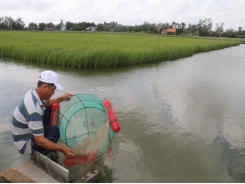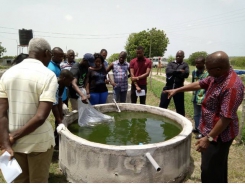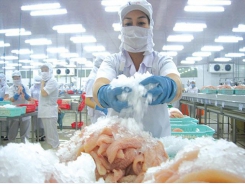How to tackle mycotoxins in aquafeeds

On the day that Mycotoxins in Aquaculture is launched, The Fish Site caught up with its co-author, Michele Muccio, mycotoxin specialist at Biomin, to find out more about how the aquaculture sector can combat these fungi-produced toxins.
What inspired your interest in aquaculture?
Aquaculture is a growing sector that plays an important role in meeting the seafood demand of billions of consumers across the globe. Biomin has been working with the aquaculture sector for many years with a full portfolio of additives for feed and pond application that promote better water quality, health, profitability and sustainability.
What are mycotoxins and why are they increasingly prevalent in aquafeed ?
Mycotoxins are immunosuppressive, toxic compounds produced by fungi or mould that impair feed intake and nutrient utilisation. They are a becoming more of a threat as we’ve seen an increasing replacement of fishmeal with plant materials, and plant materials are inevitably contaminated with mycotoxins.
How can a producer tell if there’s a mycotoxin problem in their operation? What are the signs?
If you observe reduced growth; if you observe higher FCR; if you’re spending a lot of money on feed additives that are supposed to boost your performance but it’s not really happening, it could be the result of mycotoxins. We always advise producers to take a sample of their feed and analyse it, check if there are mycotoxins, because that can be the cause of their suboptimal performance.
What impact can they have on fish and shrimp health?
Of course there are lots of species, so it’s difficult to get very specific unless you have extraordinarily high doses - then you can pinpoint some clinical symptoms like enlarged livers or altered topogenic parameters or blood parameters - but usually it all boils down to lower performance. You have a smaller size, lower weight gain, higher FCR and increased immuno-suppression, so animals are more susceptible to diseases.
Are any particular species/geographies more susceptible to being affected by mycotoxins than others?
In carnivorous species especially, we have seen a very high sensitivity towards mycotoxins, particularly deoxynivalenol, fumonisins and so on.
What are the best means of tackling mycotoxin-related issues?
We believe inactivation of mycotoxins is the way to go, especially through feed additives so that this can happen right in the gastrointestinal tract of the animal. With that route, we know we can be highly specific and we can target the toxins where they cause the problems.
Of course, because we have seen the prevalence of several types of mycotoxins, so not only aflatoxins but also deoxynivalenol, fumonisins and so on, you want to use a broad-spectrum approach. You want to use multiple strategies to detoxify multiple mycotoxins, because not all mycotoxins are the same, they have different chemical structures, different properties, so they need customized solutions to be tackled. That’s why we believe in a multi-strategy approach. There is no single binder that can bind everything that is in the feed and not bind vitamins and other nutrients.
What can the aqua sector learn from terrestrial livestock production in terms of tackling mycotoxins?
What is standard for terrestrial species is that you check your feed though regular testing of feed materials. While it’s a challenge for terrestrial species to follow the trail from the symptoms to the toxin, in aquaculture it’s even more difficult. What we say is that it is always a good investment to check your feed, because then you’re ahead of the problem and you can react straight away.
Why did you decide to publish a book on the sector?
Biomin is committed to focusing more on aquaculture, and in aquaculture we see that there is still less awareness of mycotoxins than in terrestrial animals. What we want to do is to both increase the awareness and also to help to our customers. The book gives a basic introduction as well practical examples and a lot of scientific detail, so we hope it’s really helpful.
Who is your target audience?
We wrote this book, Mycotoxins in Aquaculture, for producers so that they can learn more about mycotoxins, gain a little bit more knowledge on this topic and they can start to pay attention to it in the future. We also wrote this book for people who are starting their careers in aquaculture, students, because we know that mycotoxins in aquaculture is still a very new topic and we want to share our expertise.
Did you draw on the skills/experiences of others to compile the book?
The book compiles all the work that has been generated by the scientific community, and all of our data comes from published studies. Everything we know about mycotoxins that has been published is compiled in the book.
What are the key points you’d like your readers to absorb?
Mycotoxins are a growing threat. To reduce their negative consequences on your business, it’s advisable to be aware of the threat, test regularly for contamination and use a proven feed additive that can protect aquatic species and, ultimately, your profits.

How can mycotoxin management – and your book – help to improve the sustainability of global aquaculture?
Animals that do not suffer from the negative effects of mycotoxins are more efficient, meaning better use of resources and lower emissions. They’re also healthier, so they need less antibiotic treatment, and food safety is improved.
About the author
Michele Muccio is a product manager in the competence center mycotoxins at Biomin. He holds a BSc n biotechnology from the University of Rome ‘Tor Vergata’ and an MSc in molecular biology and biotechnology from the University of Groningen.

After his studies he worked as a researcher on the application of microalgae as animal feed and biogas production. During his studies, he participated to several international research projects in Italy, the Netherlands and Austria
Related news
Tools

Phối trộn thức ăn chăn nuôi

Pha dung dịch thủy canh

Định mức cho tôm ăn

Phối trộn phân bón NPK

Xác định tỷ lệ tôm sống

Chuyển đổi đơn vị phân bón

Xác định công suất sục khí

Chuyển đổi đơn vị tôm

Tính diện tích nhà kính

Tính thể tích ao



 Study: Fish fed yeast had better growth performance…
Study: Fish fed yeast had better growth performance…  Taiwan emerges as largest consumer of Vietnamese shrimp
Taiwan emerges as largest consumer of Vietnamese shrimp